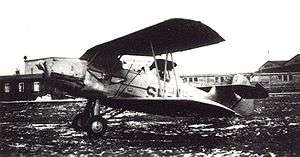Arado Ar 66
| Ar 66 | |
|---|---|
 | |
| Role | Trainer |
| Manufacturer | Arado Flugzeugwerke |
| Designer | Walter Rethel[1] |
| First flight | 1932[1] |
| Introduction | 1933 |
| Primary user | Luftwaffe |
|
| |
The Arado Ar 66 was a German single-engined, two-seat training biplane, developed in 1933. It was also used for night ground-attack missions on the Eastern Front. It was engineer Walter Rethel's last design in collaboration with Arado,[1] before Walter Blume, assigned as Arado Flugzeugwerke's chief design engineer in 1933, took over the bulk of the Arado firm's design duties.
Design and development
Arado's chief designer Walter Rethel started design of a new two-seat trainer in 1931, with the design being developed by Walter Blume when Rethel transferred to Messerschmitt, with the first prototype, the Ar 66a flying in 1932.[1][2]
The Ar 66 had an Argus As 10 air-cooled inverted V8 engine producing about 179 kW (240 hp), which drove a 2.5 m (8.2 ft) two-blade propeller. It carried 205 L (54 US gal) of fuel, and 17 L (4 US gal) of oil.[1]
The fuselage had an oval cross-section and was made of welded steel tubes, covered with fabric. The double wings provided very high lift, even at low speeds. Both wings had the same span and an 8° sweep. Construction consisted of a double pine wing spar structure, with lime tree ribs, and fabric covering. There were ailerons in both upper and lower wings. The tail had a conventional design, with the horizontal stabilizer mounted on the fuselage upper edge. The rudder was placed behind the elevator. Both the rudder and the elevator were of steel tube covered in fabric, and had a bigger surface than the first version to correct balance problems. The steel tube undercarriage was attached to the fuselage in a "V" shape and used a high-pressure rubber suspension.[1]
The crew consisted of two: instructor pilot and trainee, seated in open tandem cockpits equipped with dual controls. The aircraft was equipped with instrument flight systems with photographic cameras were mounted as optional equipment.[1]
Operational history
The Ar 66 entered service with the Luftwaffe in 1933, serving as a trainer until well into World War II.[2] In 1943, the Luftwaffe set up a number of night harassment groups to operate on the Russian front. The Ar 66, along with the Gotha Go 145, formed the main equipment of these groups.[1][2]
Variants
Data from:Aircraft of the Third Reich[1]
- Ar 66a
- Prototype
- Ar 66b
- 2nd prototype completed as a floatplane
- Ar 66B
- Production Seaplane version of Ar 66C. Two large steel hollow floats braced with iron cable. About 10 were constructed and used for seaplane training.
- Ar 66C
- Series production model with modified elevators, larger rudder, and larger-diameter wheels.
Operators
- Czechoslovakian Air Force (Postwar)
- Luftwaffe
- Nachtschlachtgruppe 2
- Nachtschlachtgruppe 3
- Nachtschlachtgruppe 5
- Nachtschlachtgruppe 8
- Nachtschlachtgruppe 12
Specifications (Ar 66C)
Data from Aircraft of the Third Reich[1]
General characteristics
- Crew: 2
- Length: 8.3 m (27 ft 3 in)
- Wingspan: 10 m (32 ft 10 in)
- Height: 2.93 m (9 ft 7 in)
- Wing area: 29.63 m2 (318.9 sq ft)
- Empty weight: 905 kg (1,995 lb)
- Max takeoff weight: 1,330 kg (2,932 lb)
- Powerplant: 1 × Argus As 10C inverted V-8 air-cooled piston engine, 179 kW (240 hp)
- Propellers: 2-bladed wooden fixed pitch propeller
Performance
- Maximum speed: 210 km/h (130 mph; 113 kn) at sea level
- Cruising speed: 175 km/h (109 mph; 94 kn) at optimum altitude
- Landing Speed: 80km/h (50 mph)
- Range: 715 km (444 mi; 386 nmi)
- Service ceiling: 4,500 m (14,764 ft)
- Rate of climb: 4.333 m/s (853.0 ft/min)
- Time to altitude: 1,000 m (3280 ft) in 4.1 minutes
Armament
- 2 kg (4.4 lb) and 4 kg (8.8 lb) anti-personnel bombs
See also
- Related lists
- List of Interwar military aircraft
- List of military aircraft of Germany
- List of World War II military aircraft of Germany
References
- Smith, J.R and Kay, Antony L. German Aircraft of the Second World War. London: Putnam, 1972. ISBN 0-85177-836-4.
- Green, William (2010). Aircraft of the Third Reich (1st ed.). London: Aerospace Publishing Limited. p. 23. ISBN 978 1 900732 06 2.
External links
| Wikimedia Commons has media related to Arado Ar 66. |